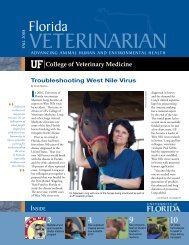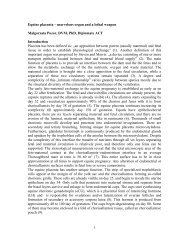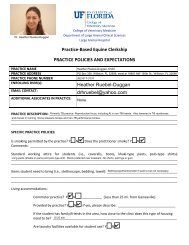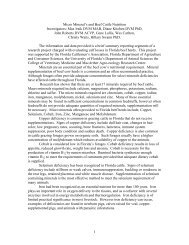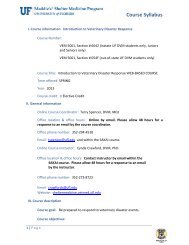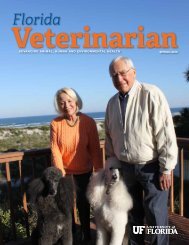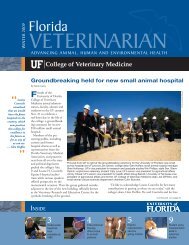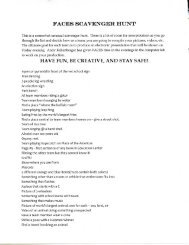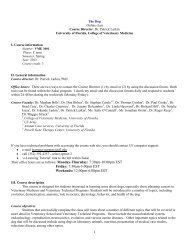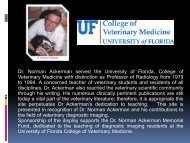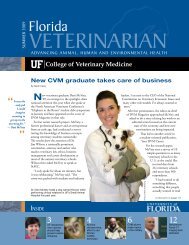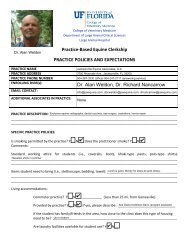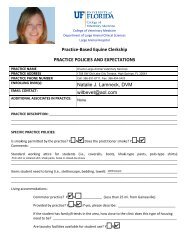College of Veterinary Medicine Research Brochure
College of Veterinary Medicine Research Brochure
College of Veterinary Medicine Research Brochure
- No tags were found...
Create successful ePaper yourself
Turn your PDF publications into a flip-book with our unique Google optimized e-Paper software.
Keeping Tick-borne Diseases at BayKKeeping the ticks that carrydeadly heartwater diseasefrom jumping U.S. borders andinfecting livestock and wildlifemight seem like an impossible task,the kind that would take a giantfence around the country.But a research team at theUniversity <strong>of</strong> Florida’s <strong>College</strong> <strong>of</strong><strong>Veterinary</strong> <strong>Medicine</strong> thinks a goodvaccine to prevent heartwaterwould be better – and more effective– than any fence.And after two decades <strong>of</strong> workingwith heartwater disease, the team ison the verge <strong>of</strong> marketing aconventional vaccine even as itworks to develop an even bettervaccine with genetic engineering.Heartwater is spread to livestockand wildlife by the bont tick, anative <strong>of</strong> Africa. The transoceanictropical bont tick has shown up inthe Caribbean, lurking just <strong>of</strong>fFlorida’s shores and making itsarrival in the United States possibleif not likely.The UF Heartwater <strong>Research</strong>Project, led by pathobiologyPr<strong>of</strong>essor Michael Burridge, hasbeen in a 20-year race against timeto understand the disease, developbetter methods to diagnose it,control the ticks that carry it andinvent a vaccine to protect against itif – or when – it arrives.Heartwater can kill up to 90 percent<strong>of</strong> the animals it infects, decimatingan entire herd. The disease damagesthe lining <strong>of</strong> blood vessels, allowingfluid to accumulate in the lungs andbody cavities, causing an agonizingdeath for the infected animal. Thetropical bont tick also is associatedwith acute dermatophilosis, adisease that causes the skin <strong>of</strong> cattleliterally to peel <strong>of</strong>f. Burridge said itis impossible to underestimate thethreat to U.S. wildlife and livestockfrom the tropical bont tick.“Heartwater is a potentialbioterrorism or agriterrorism agent,”Burridge said. “It’s a disease wedefinitely need to keep out <strong>of</strong> theUnited States.”Burridge, a parasitologist andepidemiologist, points out thatmany emerging diseases today aretick-borne. While heartwater affectscattle, sheep, goats and deer –not people – tick-borne afflictionslike Lyme disease and African tickbite fever do affect humans.Studying bont ticks may help incontrolling other disease-carryingticks, he notes.Burridge has been horrified bythe ease with which exotic tickstravel. In 1997, an injured tortoisefrom a reptile breeding facility inCentral Florida was brought toUF’s veterinary hospital fortreatment and, almost by accident,found to be carrying exotic ticks.With the United States responsiblefor more than 80 percent <strong>of</strong> worldtrade in live reptiles in the 1990s, thethreat <strong>of</strong> importing ticks via reptilesis very real.The tropical bont tick also couldjump borders by hitching a ridefrom the Caribbean to Florida ona migratory bird, like a cattle egret.Southern climates are ideal for theticks which, with wild deer as ahost, would be impossible toeradicate once they arrive.The UF team has focused much <strong>of</strong>its research <strong>of</strong>fshore. UF scientistSuman Mahan oversees the programin southern Africa, where much <strong>of</strong>the research has been successfullyfield-tested.On campus in Gainesville,pathobiology pr<strong>of</strong>essor AnthonyBarbet, who has had breakthroughsin the study <strong>of</strong> the tick-borne diseaseanaplasmosis, brings biotechnologyand its advances to the heartwaterteam. With Mahan and Burridge,Barbet has helped develop technologyfor a conventional vaccine that is onthe verge <strong>of</strong> being marketed.His focus now is on using geneticengineering to produce a recombinantDNA vaccine. Laboratory resultshave been promising, and the newvaccine would be the best tool yetin fighting heartwater.Biotechnology also has yieldedmore advanced diagnostic tests forheartwater. Previously, diagnosingheartwater required a difficult andcostly brain biopsy. In a hugeadvance, the UF heartwater teamhas developed two blood tests fordetecting the disease.“Heartwateris a potentialbioterrorism oragriterrorismagent.”Dr. Michael BurridgeAnother breakthrough has been intick control. Burridge and colleaguesinvented a bont tick decoy, whichcan be attached to the ear or tail orworn in a collar around an animal’sneck. The small, plastic tag attractsticks with pheromones then deliversa tickicide. The decoy lasts threemonths and eliminates the need forranchers to dip or spray wholeherds, which releases toxicchemicals into the environment.For tick control in wild animals,Burridge and his colleaguesdeveloped the AppliGator, whichcan be attached to a feeding troughand applies pesticide passively asdeer brush against it.Both the decoy and the AppliGatorare inexpensive and easy to use andthe AppliGator is stress-free bothfor animals and the people who needto treat them, Burridge said..Intervet International <strong>of</strong> theNetherlands, the world’s largestmanufacturer <strong>of</strong> large animalveterinary vaccines, is workingwith the UF heartwater teamto commercialize the vaccine.The Heartwater <strong>Research</strong>Program has spawned more thana dozen patents and attractedmore than $16 million in fundingfrom the U.S. Agency forInternational Development alone.Burridge says he is perhaps mostgratified by the scope andcompleteness <strong>of</strong> the project.“What we’ve done with thisheartwater project is unique inthe world. We’ve taken a diseaseand we’ve gone from the verybasic science <strong>of</strong> understanding itat the cellular level and moved onto applied science and then on tocommercialization <strong>of</strong> usefulproducts,” Burridge said. “I don’tknow <strong>of</strong> another project that hasgone from the subcellular level tocommercialization <strong>of</strong> products inthe field in quite the same way.”If – or when – the tropical bonttick jumps the U.S. border, theUF Heartwater <strong>Research</strong> Teamwill be ready.Photo left: Dr. Suman Mahan, left, andDr. Michael Burridge are shown with wild Africanbuffalo during a recent visit to South Africa.6<strong>Research</strong> • University <strong>of</strong> Florida <strong>College</strong> <strong>of</strong> <strong>Veterinary</strong> <strong>Medicine</strong>••Infectious Diseases • www.vetmed.ufl.edu7




